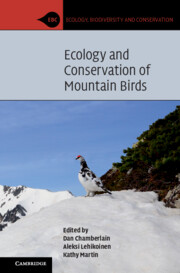Book contents
- Ecology and Conservation of Mountain Birds
- Ecology, Biodiversity and Conservation
- Ecology and Conservation of Mountain Birds
- Copyright page
- Contents
- Contributors
- Preface
- Acknowledgements
- 1 Mountain Birds and Their Habitats
- 2 Avian Adaptations to High Mountain Habitats
- 3 Global Bird Communities of Alpine and Nival Habitats
- 4 Birds of Treeline Ecotones
- 5 Population Trends of Mountain Birds in Europe and North America
- 6 Climate Change Impacts on Mountain Birds
- 7 Anthropogenic Activities and Mountain Birds
- 8 Modelling Large-Scale Patterns in Mountain Bird Diversity and Distributions
- 9 The Alpine Avifauna of Tropical Mountains
- 10 Priorities for Information, Research and Conservation of Birds in High Mountains
- Bird Species Index
- Subject Index
- Plate Section (PDF Only)
- References
9 - The Alpine Avifauna of Tropical Mountains
Published online by Cambridge University Press: 30 June 2023
- Ecology and Conservation of Mountain Birds
- Ecology, Biodiversity and Conservation
- Ecology and Conservation of Mountain Birds
- Copyright page
- Contents
- Contributors
- Preface
- Acknowledgements
- 1 Mountain Birds and Their Habitats
- 2 Avian Adaptations to High Mountain Habitats
- 3 Global Bird Communities of Alpine and Nival Habitats
- 4 Birds of Treeline Ecotones
- 5 Population Trends of Mountain Birds in Europe and North America
- 6 Climate Change Impacts on Mountain Birds
- 7 Anthropogenic Activities and Mountain Birds
- 8 Modelling Large-Scale Patterns in Mountain Bird Diversity and Distributions
- 9 The Alpine Avifauna of Tropical Mountains
- 10 Priorities for Information, Research and Conservation of Birds in High Mountains
- Bird Species Index
- Subject Index
- Plate Section (PDF Only)
- References
Summary
Tropical mountain regions are characterized by complex and mostly resident avifaunas with many small-range species and a high turnover of species across mountain ranges. On a global scale, tropical mountains show an over-representation of both recently-diverged and ancient species, making them both cradles and museums of biodiversity. Tropical mountains are characterized by slight seasonality, and local habitat gradients can be maintained over a long time. The highest levels of diversification and local endemism are found in the tree-line zone. However, a few avian families also diversified in the alpine zone. Here, many species forage by probing for invertebrates in the ground and in matted vegetation, and many species also exploit carbohydrate foods, including nectar. In an environment with few large insects, co-adapted networks of nectarivorous birds and plants play an important role. There is little published evidence of avian population changes that can be related to recent global warming, as the night-time freezing conditions in open landscapes make it difficult for arboreal vegetation to expand upslope. As glaciers melt, we should expect changes in the rich avifauna of the many periglacial Andean wetlands. Re-visits to well-documented study sites in tropical mountains are now needed to evaluate the amount of change.
- Type
- Chapter
- Information
- Ecology and Conservation of Mountain Birds , pp. 336 - 371Publisher: Cambridge University PressPrint publication year: 2023
References
- 1
- Cited by

